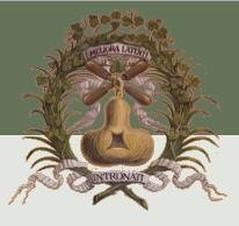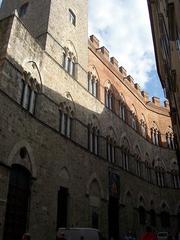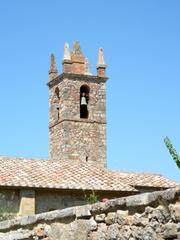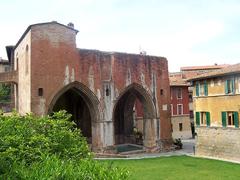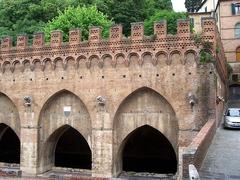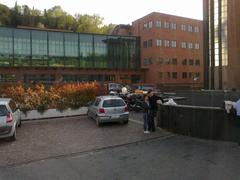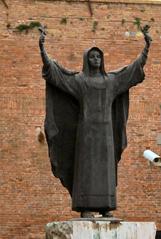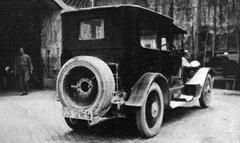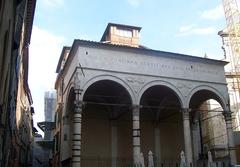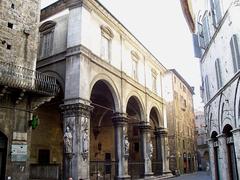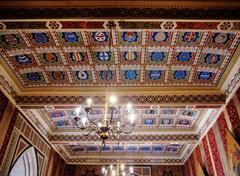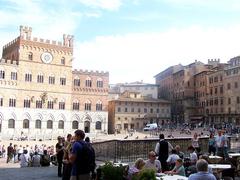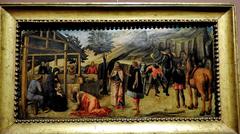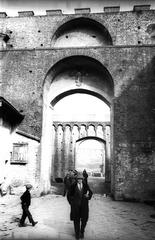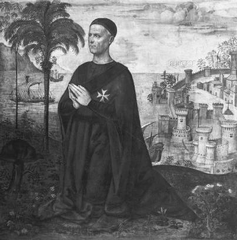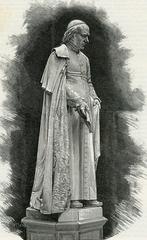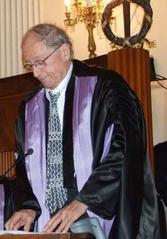Fonte dei Pispini Visiting Hours, Tickets, and Siena Historical Sites Guide
Date: 14/06/2025
Introduction to Fonte dei Pispini and Its Significance
Nestled in the historic heart of Siena, Italy, the Fonte dei Pispini—also known as the Fontana del Nicchio—is an enduring symbol of the city’s medieval ingenuity, Renaissance artistry, and vibrant community life. Located at the intersection of Via dei Pispini and Via Santa Chiara, just inside the eastern medieval walls near Porta dei Pispini, this iconic fountain was first constructed in the mid-16th century by architect Baldassarre Peruzzi. Conceived not only as a vital public water source but also as a monumental emblem for the Contrada del Nicchio, the fountain embodies Siena’s sophisticated urban water system and deep-rooted traditions.
The fountain’s unique “pispini”—water jets ingeniously hidden within sculpted masks—represent the perfect blend of function and artistic elegance. Today, visitors can explore this open-air monument free of charge, appreciating its architectural charm, historical depth, and the serene atmosphere of one of Siena’s most treasured neighborhoods. Whether your interest lies in medieval engineering, Renaissance architecture, or the living traditions of Siena’s contrade, Fonte dei Pispini offers an immersive and rewarding experience (Wikipedia - Fonte dei Pispini; Siena News; The Crazy Tourist; Palazzo Ravizza).
Table of Contents
- Introduction
- Historical Overview
- Visitor Information
- Frequently Asked Questions (FAQ)
- Visuals and Media
- Sustainability & Responsible Tourism
- Conclusion & Call to Action
- References
Historical Overview
Origins and Early Development
Fonte dei Pispini has roots dating back to 1356, when residents of the Abbadia Nuova district petitioned Siena’s government for a reliable public water source to support daily life and mitigate fire hazards. After initial attempts, a functional fountain was not completed until the late 15th century. In 1534, the community sought a more prominent structure, leading to the construction of the current monumental fountain, inaugurated in 1545 (Wikipedia - Fonte dei Pispini; Siena News).
Architectural Design and Construction
Attributed to Baldassarre Peruzzi, the fountain is Siena’s earliest “fontana monumentale.” Its design features tiered basins and water jets—“pispini”—cleverly hidden in ornate masks. This combination of utility and artistry exemplifies the Renaissance approach to public works. Water was supplied by the San Maurizio source via brick conduits, with overflow used for irrigation and local mills (Wikipedia - Fonte dei Pispini; La Mia Terra di Siena).
Etymology and Symbolic Importance
The term “Pispini” comes from the local dialect for the water spouts. The fountain’s design was so distinctive that it gave its name to the main street, the nearby city gate, and the entire district. Fonte dei Pispini became an official symbol of the Contrada del Nicchio, reinforcing neighborhood identity and pride (La Mia Terra di Siena; Siena Guide).
Role in Siena’s Water System
Fonte dei Pispini was a key node in Siena’s medieval water infrastructure, particularly the “bottini”—a vast network of underground tunnels stretching over 25 kilometers (Discover Tuscany). The fountain’s three basins were used for drinking, watering animals, and laundry, while overflow irrigated surrounding gardens. Its strategic location near Porta dei Pispini also gave it defensive significance during times of siege (La Mia Terra di Siena; Palazzo Ravizza).
Changes, Relocations, and Restorations
Fonte dei Pispini has undergone several restorations due to water supply issues and urban changes. In 1937, it was temporarily relocated to Piazza Santo Spirito to allow military access. After the upper basin collapsed in 1949, it was rebuilt in 1955. The fountain was returned to its original location in 2001, thanks to the efforts of the Contrada del Nicchio (Wikipedia - Fonte dei Pispini; Siena News).
Artistic and Urban Context
The fountain is a prime example of Renaissance ideals, blending beauty and utility. Situated near the Church of San Gaetano and Porta dei Pispini, it anchors a historic quarter rich in civic, religious, and defensive landmarks (Siena Guide). The surrounding alleys, such as Vicolo degli Orefici, echo Siena’s medieval urban fabric and may have once formed part of the Via Francigena pilgrimage route (Palazzo Ravizza).
Visitor Information
Visiting Hours & Tickets
- Hours: Open 24 hours a day, every day.
- Tickets: No entry fee required. Fonte dei Pispini is freely accessible as a public monument.
Location & Directions
- Address: Intersection of Via dei Pispini and Via Santa Chiara, Siena, Italy.
- Getting There: About a 15-minute walk from Piazza del Campo. Follow pedestrian-friendly streets or use local buses stopping near Porta dei Pispini. If arriving by car, park at lots outside the city walls and continue on foot (Tripomatic).
Accessibility
- The fountain is set slightly below street level, accessed by a short flight of steps with no handrails.
- Cobblestone streets and mild inclines may challenge visitors with limited mobility or wheelchairs.
- Assistance is recommended for those with mobility concerns.
Nearby Attractions & Combining Visits
- Porta dei Pispini: Adjacent medieval gate, notable for its architecture.
- Church of San Gaetano: Renaissance church near the fountain.
- Contrada del Nicchio Museum: Insight into the district’s heritage.
- Fortino Baldassare Peruzzi: Small fortification nearby, part of Siena’s defensive network.
- Other Fountains: Fonte Gaia and Fontebranda, key parts of Siena’s water system (Podere Santa Pia).
Travel Tips
- Footwear: Wear comfortable shoes for cobblestones and gentle slopes.
- Best Photography: Early morning or late afternoon light is ideal.
- Picnics: Enjoy green spaces near the city walls, especially in warm weather.
- No Restrooms/Refreshments: Facilities are available near Piazza del Campo.
- Local Etiquette: Respect the monument, keep noise low, and avoid climbing or littering.
- Language: Italian is primary, but English is widely understood in tourist areas.
Frequently Asked Questions (FAQ)
Q: What are the visiting hours for Fonte dei Pispini?
A: The site is open 24 hours a day, year-round.
Q: Is there an entrance fee?
A: No, Fonte dei Pispini is free to visit.
Q: Are guided tours available?
A: Yes, local walking tours of Siena’s historic neighborhoods and fountains typically include Fonte dei Pispini. Some specialized tours cover the bottini aqueducts.
Q: Is the site wheelchair accessible?
A: Accessibility is limited due to steps and cobblestone surfaces; assistance is recommended.
Q: Can I take photographs?
A: Absolutely—Fonte dei Pispini is a photogenic site, particularly in soft natural light.
Q: Is the fountain water drinkable?
A: No, the water is not potable. Use designated public fountains for drinking water.
Visuals and Media
- Fonte dei Pispini and the surrounding district offer excellent opportunities for photography, especially during sunrise and sunset.
- Maps and virtual tours are available on local tourism websites.
- Artists may find inspiration in the fountain’s Renaissance details and tranquil atmosphere.
Sustainability & Responsible Tourism
- Use city bins for litter.
- Support local businesses and artisans.
- Avoid climbing or damaging the fountain.
- Be considerate of residents and keep noise levels low.
Conclusion & Call to Action
Fonte dei Pispini is more than a historic fountain—it is a living testament to Siena’s ingenuity, civic pride, and communal heritage. Its strategic location and integration into the city’s aqueduct network make it a prime example of medieval urban planning and Renaissance art. Open at all hours and free to visit, Fonte dei Pispini invites you to connect with Siena’s past and explore its vibrant neighborhoods.
To make the most of your visit:
- Include Fonte dei Pispini on a walking tour of Siena’s eastern districts.
- Explore nearby monuments, such as Porta dei Pispini and the Contrada del Nicchio Museum.
- Download the Audiala app for guided tours, insider tips, and event updates.
- Follow us on social media for the latest recommendations and travel inspiration for Siena and Tuscany.
Embrace the charm and history of Siena—start your journey at Fonte dei Pispini!
References and Further Reading
- Fonte dei Pispini, 2024, Wikipedia (https://it.wikipedia.org/wiki/Fonte_dei_Pispini)
- Fonte dei Pispini Restoration and History, 2024, Siena News (https://sienanews.it/cultura/in-santa-chiara-ce-una-bella-fonte-la-fonte-dei-pispini-torna-nel-luogo-per-il-quale-era-stata-costruita/)
- Best Things to Do in Siena, 2024, The Crazy Tourist (https://www.thecrazytourist.com/15-best-things-siena-italy/)
- Siena City Walls Historic Itinerary, 2024, Palazzo Ravizza (https://palazzoravizza.it/en/itineraries/siena-city-walls-historic-itinerary-2/)
- Discover the Ancient Fountains of Siena, 2024, Discover Tuscany (https://www.discovertuscany.com/siena/what-to-do/discover-the-ancient-fountains-of-siena.html)
- Porta dei Pìspini Gothic Gate Guide, 2024, Siena Guide (http://siena-guide.com/documents/SantoSpiritoandPispiniFountainandGate.pdf)
- Porta dei Pìspini and Siena Attractions, 2024, Tripomatic (https://tripomatic.com/en/poi/porta-dei-pispini-siena-poi:8776388)
- Podere Santa Pia (http://www.poderesantapia.com/album/siena/fontidisiena.htm)
- Traveling in Tuscany (http://www.travelingintuscany.com/engels/siena/fontidisiena.htm)
